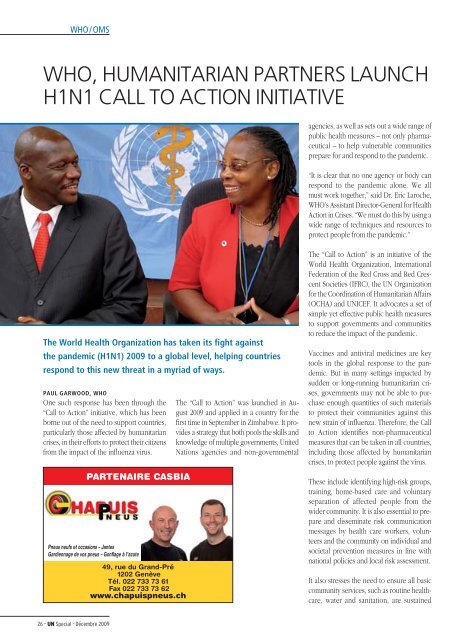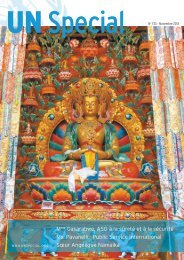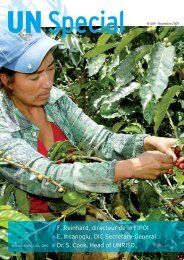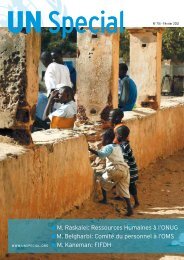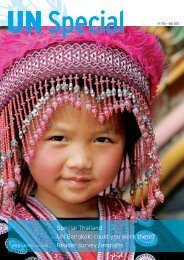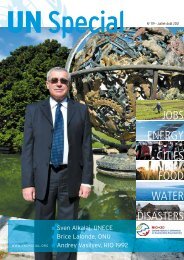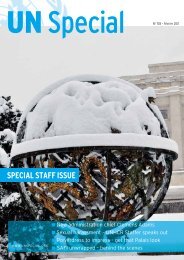WHO / OMSWHO, HUMANITARIAN PARTNERS LA<strong>UN</strong>CHH1N1 CALL TO ACTION INITIATIVEagencies, as well as sets out a wide range ofpublic health measures – not only pharmaceutical– to help vulnerable communitiesprepare for and respond to the pandemic.“It is clear that no one agency or body canrespond to the pandemic alone. We allmust work together,” said Dr. Eric Laroche,WHO’s Assistant Director-General for HealthAction in Crises. “We must do this by using awide range of techniques and resources toprotect people from the pandemic.”The World Health Organization has taken its fight againstthe pandemic (H1N1) 2009 to a global level, helping countriesrespond to this new threat in a myriad of ways.PAUL GARWOOD, WHOOne such response has been through the“Call to Action” initiative, which has beenborne out of the need to support countries,particularly those affected by humanitariancrises, in their efforts to protect their citizensfrom the impact of the influenza virus.PARTENAIRE CASBIAPneus neufs et occasions – JantesGardiennage de vos pneus – Gonflage à l’azote49, rue du Grand-Pré1202 GenèveTél. 022 733 73 61Fax 022 733 73 62www.chapuispneus.chThe “Call to Action” was launched in August2009 and applied in a country for thefirst time in September in Zimbabwe. It providesa strategy that both pools the skills andknowledge of multiple governments, UnitedNations agencies and non-governmentalThe “Call to Action” is an initiative of theWorld Health Organization, InternationalFederation of the Red Cross and Red CrescentSocieties (IFRC), the <strong>UN</strong> Organizationfor the Coordination of Humanitarian Affairs(OCHA) and <strong>UN</strong>ICEF. It advocates a set ofsimple yet effective public health measuresto support governments and communitiesto reduce the impact of the pandemic.Vaccines and antiviral medicines are keytools in the global response to the pandemic.But in many settings impacted bysudden or long-running humanitarian crises,governments may not be able to purchaseenough quantities of such materialsto protect their communities against thisnew strain of influenza. Therefore, the Callto Action identifies non-pharmaceuticalmeasures that can be taken in all countries,including those affected by humanitariancrises, to protect people against the virus.These include identifying high-risk groups,training, home-based care and voluntaryseparation of affected people from thewider community. It is also essential to prepareand disseminate risk communicationmessages by health care workers, volunteersand the community on individual andsocietal prevention measures in line withnational policies and local risk assessment.It also stresses the need to ensure all basiccommunity services, such as routine healthcare,water and sanitation, are sustained26 – <strong>UN</strong> <strong>Special</strong> – Décembre 2009
during any pandemic response as broaderpublic health relies on these as well.More than fifty participants took part in theinitial rollout of the initiative in Zimbabwe,including senior Zimbabwean Ministry ofHealth and Child Welfare officials and expertsfrom key <strong>UN</strong>, international and localorganisations, the United States Centres forDisease Control and Prevention, Atlanta,and government missions.Zimbabwe was chosen as the first countryto apply the Call to Action because of theexperiences faced, and lessons learned,from its 2008–2009 cholera outbreak thatinfected almost 100,000 people and killed4000. In response to the cholera epidemic,Zimbabwean authorities and WHO, Zimbabwedrew up its own proposed H1N1pandemic preparedness and response planand committed, in a “Harare Declaration onPreparedness and Response to the InfluenzaA (H1N1) Pandemic” issued at the end of themeeting, to apply the “Call to Action” measuresto its own national pandemic plan.Immobilier“Zimbabwe has learned a lot from the choleraoutbreak. It has developed systems thatwill prevent a cholera outbreak of such ascale ever happening again. And the samesystem will be instrumental in protecting thepublic from the impact of this new H1N1pandemic,” said Dr. Custodia Mandlhate,WHO’s Representative to Zimbabwe.One of the Call to Action’s key initiativeshas been to bring humanitarian and healthpartners together to work in a unified fashionto protect the health of the world’s mostvulnerable from the new pandemic.“The Call to Action is significant becauseit represents a joint effort by humanitarianactors to better prepare for and respond tothe H1N1 pandemic to protect the health ofall people, particularly those from countriesmost in need,” said Dr. Heather Papowitz,the Pandemic and Community PreparednessFocal Point for WHO’s Health Actionin Crises. ❚Useful linksWHO:http://www.who.int/csr/disease/swinefl u/en/index.htmlCall to Action:http://www.who.int/csr/resources/publications/swinefl u/20090817_call_to_action_en.pdfIFRC:http://www.ifrc.org/what/health/relief/best_defence.asp<strong>UN</strong>ICEF:http://www.unicef.org/fl u/pandemic/index.htmlHarare Declaration:http://www.who.int/hac/crises/zwe/HarareH1N1Declaration309090.pdfA selection from our portfolioAPARTMENTS FOR SALEPETIT-SACONNEX : A very fine 7-room apartment, in perfect condition, situated in aquiet residence, near the shops and international organizations. Living area : 154 m 2 .CHF 1,630,000.–EAUX-VIVES : An exceptional 4-room apartment at the heart of Geneva. Ideally located,this dwelling of one’s dreams with a unique character affords a view of the city’s roofs.Living area : 118 m 2 .CHF 1,500,000.–FLORISSANT PARC-BERTRAND : This delightful 3-room apartment is situated on thetop floor of a building with character dating from the beginning of the last century, in oneof Geneva’s most sought-after districts. Living area : 94,20 m 2CHF 1,370,000.–LES RÉSIDENCES DE CHAMPAGNEPETIT-SACONNEXBEAUTIFUL 8 ROOMS’ APPARTMENTV , 223 sqm 5 s . L m, , - m, ms, ms, 2 s 2 sqm . . R. 518FR. 2’490’000.--GRANGE & CIE SA SALES DEPARTMENT21-23, CHEMIN DE GRANGE-CANAL1208 GENEVA | TÉL : 022 707 10 50FAX : 022 707 10 03 | WWW.GRANGE.CHFOR SALEAVUSY :DELIGHTFUL SEMI-DETACHEDVILLAS FOR SALE OFF-PLAN• A bucolic setting• Traditional architecture• Meticulous construction andfinishings• Comfortable interior living space2• Plots from 140 m to 375 m 2 .Prices ranging between CHF 1,250,000.– and CHF 1,500,000.–Available: 2 nd semester of 2011SOCIÉTÉ PRIVÉE DE GÉRANCE022 849 61 40 – www.spg.chspgvente@spg.chGroupe SPG-RYTZ27 – <strong>UN</strong> <strong>Special</strong> – Décembre 2009


